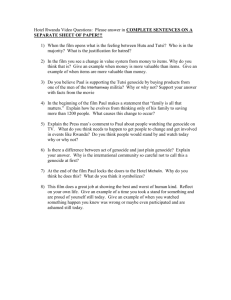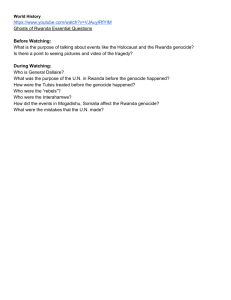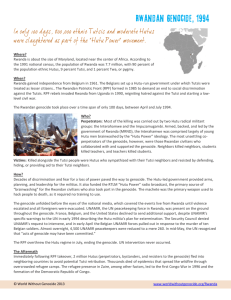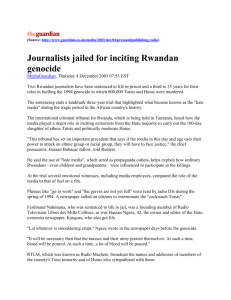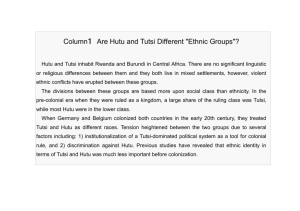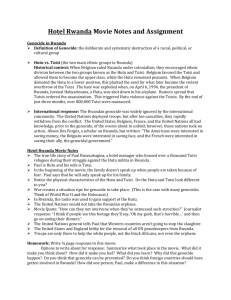Hutu Ten Commandments
advertisement
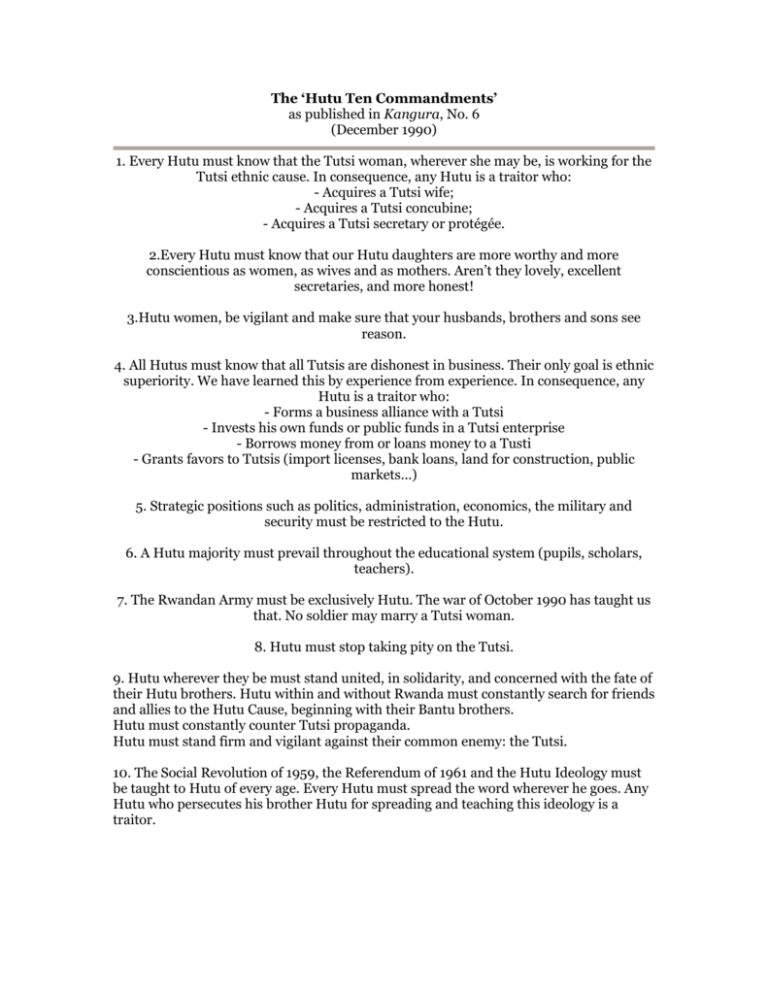
The ‘Hutu Ten Commandments’ as published in Kangura, No. 6 (December 1990) 1. Every Hutu must know that the Tutsi woman, wherever she may be, is working for the Tutsi ethnic cause. In consequence, any Hutu is a traitor who: - Acquires a Tutsi wife; - Acquires a Tutsi concubine; - Acquires a Tutsi secretary or protégée. 2.Every Hutu must know that our Hutu daughters are more worthy and more conscientious as women, as wives and as mothers. Aren’t they lovely, excellent secretaries, and more honest! 3.Hutu women, be vigilant and make sure that your husbands, brothers and sons see reason. 4. All Hutus must know that all Tutsis are dishonest in business. Their only goal is ethnic superiority. We have learned this by experience from experience. In consequence, any Hutu is a traitor who: - Forms a business alliance with a Tutsi - Invests his own funds or public funds in a Tutsi enterprise - Borrows money from or loans money to a Tusti - Grants favors to Tutsis (import licenses, bank loans, land for construction, public markets...) 5. Strategic positions such as politics, administration, economics, the military and security must be restricted to the Hutu. 6. A Hutu majority must prevail throughout the educational system (pupils, scholars, teachers). 7. The Rwandan Army must be exclusively Hutu. The war of October 1990 has taught us that. No soldier may marry a Tutsi woman. 8. Hutu must stop taking pity on the Tutsi. 9. Hutu wherever they be must stand united, in solidarity, and concerned with the fate of their Hutu brothers. Hutu within and without Rwanda must constantly search for friends and allies to the Hutu Cause, beginning with their Bantu brothers. Hutu must constantly counter Tutsi propaganda. Hutu must stand firm and vigilant against their common enemy: the Tutsi. 10. The Social Revolution of 1959, the Referendum of 1961 and the Hutu Ideology must be taught to Hutu of every age. Every Hutu must spread the word wherever he goes. Any Hutu who persecutes his brother Hutu for spreading and teaching this ideology is a traitor. By Gregory H. Stanton, President, Genocide Watch Classification Symbolization Dehumanization Organization Polarization Preparation Extermination Denial Genocide is a process that develops in eight stages that are predictable but not inexorable. At each stage, preventive measures can stop it. The process is not linear. Logically, later stages must be preceded by earlier stages. But all stages continue to operate throughout the process. 1. CLASSIFICATION: All cultures have categories to distinguish people into “us and them” by ethnicity, race, religion, or nationality: German and Jew, Hutu and Tutsi. Bipolar societies that lack mixed categories, such as Rwanda and Burundi, are the most likely to have genocide. The main preventive measure at this early stage is to develop universalistic institutions that transcend ethnic or racial divisions, that actively promote tolerance and understanding, and that promote classifications that transcend the divisions. The Catholic church could have played this role in Rwanda, had it not been riven by the same ethnic cleavages as Rwandan society. Promotion of a common language in countries like Tanzania has also promoted transcendent national identity. This search for common ground is vital to early prevention of genocide. 2. SYMBOLIZATION: We give names or other symbols to the classifications. We name people “Jews” or “Gypsies”, or distinguish them by colors or dress; and apply the symbols to members of groups. Classification and symbolization are universally human and do not necessarily result in genocide unless they lead to the next stage, dehumanization. When combined with hatred, symbols may be forced upon unwilling members of pariah groups: the yellow star for Jews under Nazi rule, the blue scarf for people from the Eastern Zone in Khmer Rouge Cambodia. To combat symbolization, hate symbols can be legally forbidden (swastikas) as can hate speech. Group marking like gang clothing or tribal scarring can be outlawed, as well. The problem is that legal limitations will fail if unsupported by popular cultural enforcement. Though Hutu and Tutsi were forbidden words in Burundi until the 1980’s, code-words replaced them. If widely supported, however, denial of symbolization can be powerful, as it was in Bulgaria, where the government refused to supply enough yellow badges and at least eighty percent of Jews did not wear them, depriving the yellow star of its significance as a Nazi symbol for Jews. 3. DEHUMANIZATION: One group denies the humanity of the other group. Members of it are equated with animals, vermin, insects or diseases. Dehumanization overcomes the normal human revulsion against murder. At this stage, hate propaganda in print and on hate radios is used to vilify the victim group. In combating this dehumanization, incitement to genocide should not be confused with protected speech. Genocidal societies lack constitutional protection for countervailing speech, and should be treated differently than democracies. Local and international leaders should condemn the use of hate speech and make it culturally unacceptable. Leaders who incite genocide should be banned from international travel and have their foreign finances frozen. Hate radio stations should be shut down, and hate propaganda banned. Hate crimes and atrocities should be promptly punished. 4. ORGANIZATION: Genocide is always organized, usually by the state, often using militias to provide deniability of state responsibility (the Janjaweed in Darfur.) Sometimes organization is informal (Hindu mobs led by local RSS militants) or decentralized (terrorist groups.) Special army units or militias are often trained and armed. Plans are made for genocidal killings. To combat this stage, membership in these militias should be outlawed. Their leaders should be denied visas for foreign travel. The U.N. should impose arms embargoes on governments and citizens of countries involved in genocidal massacres, and create commissions to investigate violations, as was done in post-genocide Rwanda. 5. POLARIZATION: Extremists drive the groups apart. Hate groups broadcast polarizing propaganda. Laws may forbid intermarriage or social interaction. Extremist terrorism targets moderates, intimidating and silencing the center. Moderates from the perpetrators’ own group are most able to stop genocide, so are the first to be arrested and killed. Prevention may mean security protection for moderate leaders or assistance to human rights groups. Assets of extremists may be seized, and visas for international travel denied to them. Coups d’état by extremists should be opposed by international sanctions. 6. PREPARATION: Victims are identified and separated out because of their ethnic or religious identity. Death lists are drawn up. Members of victim groups are forced to wear identifying symbols. Their property is expropriated. They are often segregated into ghettoes, deported into concentration camps, or confined to a famine-struck region and starved. At this stage, a Genocide Emergency must be declared. If the political will of the great powers, regional alliances, or the U.N. Security Council can be mobilized, armed international intervention should be prepared, or heavy assistance provided to the victim group to prepare for its self-defense. Otherwise, at least humanitarian assistance should be organized by the U.N. and private relief groups for the inevitable tide of refugees to come. 7. EXTERMINATION begins, and quickly becomes the mass killing legally called “genocide.” It is “extermination” to the killers because they do not believe their victims to be fully human. When it is sponsored by the state, the armed forces often work with militias to do the killing. Sometimes the genocide results in revenge killings by groups against each other, creating the downward whirlpool-like cycle of bilateral genocide (as in Burundi). At this stage, only rapid and overwhelming armed intervention can stop genocide. Real safe areas or refugee escape corridors should be established with heavily armed international protection. (An unsafe “safe” area is worse than none at all.) The U.N. Standing High Readiness Brigade, EU Rapid Response Force, or regional forces -- should be authorized to act by the U.N. Security Council if the genocide is small. For larger interventions, a multilateral force authorized by the U.N. should intervene. If the U.N. is paralyzed, regional alliances must act. It is time to recognize that the international responsibility to protect transcends the narrow interests of individual nation states. If strong nations will not provide troops to intervene directly, they should provide the airlift, equipment, and financial means necessary for regional states to intervene. 8. DENIAL is the eighth stage that always follows a genocide. It is among the surest indicators of further genocidal massacres. The perpetrators of genocide dig up the mass graves, burn the bodies, try to cover up the evidence and intimidate the witnesses. They deny that they committed any crimes, and often blame what happened on the victims. They block investigations of the crimes, and continue to govern until driven from power by force, when they flee into exile. There they remain with impunity, like Pol Pot or Idi Amin, unless they are captured and a tribunal is established to try them. The response to denial is punishment by an international tribunal or national courts. There the evidence can be heard, and the perpetrators punished. Tribunals like the Yugoslav or Rwanda Tribunals, or an international tribunal to try the Khmer Rouge in Cambodia, or an International Criminal Court may not deter the worst genocidal killers. But with the political will to arrest and prosecute them, some may be brought to justice. © 1998 Gregory H. Stanton. Originally presented as a briefing paper at the US State Department in 1996. Name: Case Study: Hutu and Tutsi in Rwanda and Burundi 1) Define otherness (one aspect must focus on criteria)- 2) How different does a person have to be before being classified as other? Set a criteria for the US or Western Hemisphere. 3) How important is the degree of similarities and differences? Why? 4) Is nationality or ethnicity a genetic, cultural, territorial or psychological phenomenon? Read Overview 5) Jot down elements of ethnic conflict below: What Role has Ethnicity Played? 6) What makes a Hutu? 7) What makes a Tutsi? 8) After comparing the criteria above, determine if ethnicity is genetic, social, political, cultural, territorial or psychological. What Role has History Played? 9) How has history defined both groups? Hutu Tutsi 10) After comparing the criteria above, determine if ethnicity is genetic, social, political, cultural, territorial or psychological. 11) What role did colonialism play? That damn Berlin Conference and World War I. 12) Think about the maps we shaded in a few classes ago. What is the connection? 13) Why would the Hutu want to overthrow the Belgian supported Tutsi? Was this a valid reason? At what point does genocide become protecting one’s own self interest from a perceived threat? 14) What role does nationalism and the idea of a revolutionary vanguard play? What Role did Leadership Play? 15) What was Habyarimana’s goal? What was he? 16) What form of government did he operate? 17) Did his government encourage or discourage ethnic tension? Timeline 1926-1964 18) Why did the Tutsi elite flee Rwanda in 59? 19) What do you think the goal of the Tutsi guerillas would be? 20) Why did the Hutus respond drastically during 1964? Timeline 1973-1993 21) What is the goal of the RPF? 22) What motivated government policies during this time? 23) How did Habyarimana institute contradictory policies? Timeline 1994-1995 24) How did Habyarimana’s assassination create further complications? 25) How did militias and the Presidential Guard impact the situation? 26) How does this reading support the yearly themes of this class? 27) Use the reading to defend the quote below. "We dead, we dead are a vaster army Than those on land, than those at sea! And all our loves and hates and strifes Still flow above us in mortal veins." C.S. Meyer Name: Hotel Rwanda I am going to assume that the majority of you have watched this movie in Global Studies. Therefore, if you are watching this movie for a second time, the movie should have a different meaning to you after studying the historiography of genocide. 1) Identify aspects of the following: Long Term Hatred Propaganda Buying into Ideology Process Victim, Perpetrators and Bystanders 2) What responsibility did the UN have to the people of Rwanda? 3) What role did the ½ play in the movie? By ½ I mean a combination of Hutu and Tutsi similar to ½ German and Jew. 4) After studying genocide for a few months, what aspects of genocide historiography does this movie touch on? 5) How are you looking for different issues in this movie as a result of taking this class? Historiography: How historians analyze and write history about a certain topic. For example, the historiography of the Civil War in America focuses on constant elements that when combined tell the story of the Civil War. Thus the Civil War historiography focuses on slavery, differences between North and South as well as 1800 politics. Name: 1) Define pregnancy of war. Bastards of Rwanda 2) Does rape count as process? 3) What if the victim of rape is left to survive? 4) How did women deal with their children? 5) How should Rwanda teach about their genocide? Compare to Final Cut and our first Socratic seminar. From Court Convicts Three 6) Are these individuals guilty? 7) Did the individuals actually kill anyone? Did Hitler? 8) The article is very critical of the international reaction. If it was possible to hold the international community accountable, then should this group also be on trial? Name: Task: Locate map A and pretend you are at a meeting with two other nations. Your task is to divide up that land between the three groups. You can color the dividing lines or create a symbol. While completing this task the following issues need to be addressed: 1-What people possibly live on this land? 2-How will these people be different from your kind? 3-What will you do with the native population? 4-How will you protect your interest in this region? Your interest could be economic and/or imperial. 5-How will you govern this area? 6-How will you protect this area? 7-What are the pros and cons of your plan? 8-What is your overall conclusion? Now move on to maps B and C and address the same issues. Name: Rwanda Leader & Rwanda Plane Crash Articles 1) What did Kagame have to gain? 2) What was the cost? 3) Consider the French connection. What role did global politics play in the genocide? 4) What about the Cambodian Genocide? Rwanda Probing Plane Crash 5) What new evidence was uncovered? Rwanda Suspect Caught in France 6) Why France? Looking Back 7) Why does the writer focus on the UN and US role? Name: Colonial Rule in Africa 1) What was the difference between British and French rule? 2) What was/is the pro and con of each? 3) Why line 7 4) Be prepared to discuss the questions mentioned in paragraph 3. Name: Chapter 25 1) Describe the changing relationship between Africa and Europe. 2) Did colonialism help or hurt the development of Africa? Defend. 3) Locate references to assimilation in the reading. Name: Rwanda Witness 1) Connect Somalia to the end of the Vietnam War. 2) What evidence cited supports the UN as perpetrator or bystander? 3) How does the author address radio propaganda and the killing of the president? 4) PTSD 5) How will your god or humanity judge Dallaire’s actions? 6) Consider the last paragraph. What do you think Dallaire would do differently if he could go back to that time period? A Good Man in Hell 7) What are your thoughts on nations not having friends just self interests? 7) What was the UN job/mission? 8) Define presidential proposition. Sometimes entertainment takes from history and acts like a commentary on later times. The following list explains this idea: War of the Worlds-Addresses the issue of colonialism and the idea of rejecting this foreign policy. Chicken run-indirect storyline that deals with the Holocaust. Star Wars III Revenge of the Sith-Balance of power falls into the wrong hands after crisis allows government more powers (think Hitler and the Reichstag). Your task is to create a creative story that focuses on genocide. At this point, you should be able to identify yearly themes that are similar in the genocides we have studied. Your story must address eight of the following themes: Conditions-Does genocide take place during a certain crisis? Think about the role of the Vietnam War or the Treaty of Versailles as issues that created conditions. Political power struggle-Think about the Weimar Republic, the Young Turks or the Tutsi/Hutu political struggle. Assimilation-Identify a group that has a perceived refusal to accept the norms of the majority. Think Jews not assimilating into German society. Yearly themes (long term hatred, belief in cause justification ideology, propaganda, process and allowing atrocities). Outcome-How does your story end? Will it be total slaughter or justice? DenialThe “other” NationalismInternational response Following orders Perpetrator, victim, bystander and hero Character names that reference historic figures-The show Lost has a character name Locke and Rousseau. Both were philosophers writing about man in the state of nature. Hence Lost is a show about plane crash survivors trying to live without a set of laws. Your characters should reference historic figures. Rubric: Creativity Tells original story Uses a minimum of ten of the themes listed above Story projects an understanding of yearly themes Oral presentation about your project? What did you produce? Format 1-Comic book 2-Collection of poems with visuals and maps 3-Documentary 4-Video game that will tell the story of the genocide. This format assumes the genocide was a success. Therefore, the game is a piece of propaganda and a lesson. Video game must include a box, CD and directions. 5-Creative story 6-Research Essay-Pretend you have researched your genocide and turn in a fake essay with fake sources. 7-Memorial website-You are designing a memorial site that will inform the visitor about the history using maps and other visual aids. A collection of memorial images should also be a part of this task. Do Not 1-Turn in a cute type story of a crayon genocide or bears. Your story must involve human beings. 2-Your story must take place during a stage of imperialism, war or a decline of society. In other words, create a historic context for your story. Zero Game The White House May 3, 1994 1) How is the Cold War viewed and why? 2) What restricted the UN from doing its job? 3) How does lines 8-9 sum up the idea of a power vacuum? 4) Why build up public and congressional support? 5) Which would be the better organization to deal with genocide? US 6) What are the pros and cons of a US genocide intervention? 7) What was the presidential directive? 8) Why was the directive issued? 9) How did the US undermine UN objectives? Line 25. 10) Conclusion: 11) Role of the Cold War UN Name: 1) How does the author describe the Parmehutu? 2) What was the motivation for the 1972 coup? 3) What was the importance of 6 April 1994? 4) What is the aim of this author’s study? Geography Reading WILLIAM B WOOD ARTICLE 5) Why does the author claim no two genocides are the same? 6) How does the author address other genocides? 7) Locate the underlined sections labeled with a GQ. Which potential quote do you agree with and why? The Battle of Mogadishu (also referred to as the "Battle of the Black Sea") or for Somalis Ma-alinti Rangers (“The Day of the Rangers”) was a battle that was part of Operation Gothic Serpent that was fought on October 3 and 4, 1993, in Mogadishu, Somalia, by forces of the United States supported by UNOSOM II against Somali militia fighters loyal to warlord Mohamed Farrah Aidid. The battle is also referred to as the First Battle of Mogadishu to distinguish it from the later Second Battle of Mogadishu. Name: Primary Doc 000 Game Under Secretary of Defense May 5, 1994 1) Why jam the radio broadcasts? 2) How did the memo writers take a cost-benefit analysis approach to the issue? P. 126-127 3) What were the aims of the meetings? 4) Why mention Belgium? 5) How does the informant deal with following orders? 6) What evidence suggests the genocide in Rwanda was planned? 7) What does the informant want? Unclassified Document 8) What was Resolution 909? 9) What do the authors of the document believe about the potential situation in Rwanda? 10) What was UNAMIR? 11) What appears to be the main concern of the document text? Think people. 12) Read point 7. What good does condemning do for the people on the ground in Rwanda? Executive Summary Briefing 13) How does the document address the following issues: RPF- Power Struggle- Burundi- Security Council- Long Term- Ooo say can you see. Ghosts of Rwanda 1) How does the video portray gen. Dallaire? 2) What were the Hutus forced to do? Share power. How have the two groups become victims to the cycle of hate? 3) What role did Kagale play? 4) How did Dallaire deal with following orders? 5) How did the video address Mogadeshu? 6) What weapons were imported? 7) How did the video address the plane crash incident? 8) Prime Minister vs. Colonel Moderate Hardliner 9) Why was it important for the Hutu hardliners to get the Belgians out of the country/ 10) Do you agree with the immediate US response to withdraw? 11) A-------------------B 12) Identify process 13) What group fights back as a reaction to the genocide? 14) What was odd and the point of the French entry? 15) How were flags used? 16) Feeling that we had to die 17) What heroes emerged? 18) 10 Belgians died and the US was relieved about evacuation results. What about humanity? 19) Cut the losses 20) Identify stratified ideology once foreign agents were removed 21) Why do bodies always present a problem for genocide planners? Which genocide perpetrators designed the bestest solution? 22) Death of 6 Red Cross workers granted the Red Cross full access to save lives. Was this a fair price? If only eight people are rescued, is the price still fair? 23) Shutting up is the same as participating 24) Documentary bias 25) EW, A E, WB 26) Capability of US Marines to be anywhere in the world in 24 hours 27) Loophole of words 28) July 94 100 days until Tutsis win civil war 29) Why criticize the US so much? Article 1 The Contracting Parties confirm that genocide, whether committed in time of peace or in time of war, is a crime under international law which they undertake to prevent and to punish. Article 2 In the present Convention, genocide means any of the following acts committed with intent to destroy, in whole or in part, a national, ethnical, racial or religious group, as such: (a) Killing members of the group; (b) Causing serious bodily or mental harm to members of the group; (c) Deliberately inflicting on the group conditions of life calculated to bring about its physical destruction in whole or in part; (d) Imposing measures intended to prevent births within the group; (e) Forcibly transferring children of the group to another group. Name: Rwanda Test 1) _____Prior to European interaction with Africa, Europeans viewed Africa as… A) Backwards B) Inferior C) Racist D) Dark Continent Imperialism Section 2) _____Imperialism Reaction A) Accept or reject 3) _____Imperialism outcome B) Resources 4) _____Megatron C) Force 5) _____Imperialism pro from European view D) Unstable governments 6) _____Berlin Conference E) Carves up Africa Additional Imperialism Stuff 7) _____Assimilation A) Assimilate them into our culture 8) _____French method of control B) Accepting the majority group’s way of life 9) _____British method of control C) Need for additional living space 10) _____Lebansraum D) Indirect working with Africans E) Use of military strength to occupy Role of World War I 11) _____Treaty of Versailles A) Belgium controls 12) _____German colonies B) Cause for World War I 13) _____First genocide C) Use of imperialism 14) _____Berlin Conference D) Armenian E) Removes German colonies 15) A) B) C) D) _____What lesson did the class learn from coloring and dividing maps into sections? Colonizers have no regard for differences Ethnic, racial and physical location once split up lead to problems Merging different groups into one area is probably not the best way to use foreign policy New imperialism had no regard for differences and created future problems 16) _____Which of the following did the Berlin Conference not directly achieve in Africa? A) Stratification B) Colonialism C) Economic differences D) Differences E) Genocide 17) _____Hutu A) African in appearance if using physical differences 18) _____Tutsi B) European in appearance if using physical differences 19) _____Put the following events in chronological order 1-Victim of imperialism 2-WWI 3-Decolonization/independence 5-Unstable government 6-Do nothing 7-Genocide A) 4123576 B) 867-5309 Nationalism 20) _____Parmehutu C) 4132756 D) 4135726 4-Alone E) 4213576 A) Group of intellectuals later merged with a more radical wing 21) _____MRND B) Extremist group 22) _____RANU C) Created by refugees and attacked Rwanda 23) _____RPF D) Replaced Parmehutu 24) _____CDR E) Leads social revolution of 59 25) A) B) C) D) _____Which of the following outlines the Introduction reading thesis? Rwanda and Burundi must be studied to understand the genocide Carve up of Africa created the environment that resulted numerous African problems The Hutu and Tutsi power struggle was more of a civil war between two parties Power vacuum was the main cause for the genocide 26) A) B) C) D) E) ______Which of the following explains the importance of the 1959 social revolution? Rwanda gained independence Hutus gained power Tutsi gained power Civil war begins in Rwanda C and D Identify the following groups as Hutu or Tutsi 27) _____Parmehutu 28) _____MRND 29) _____RANU A) Hutu 30) _____RPF B) Tutsi 31) _____CDR 32) _____The coup in 1972 was led by and resulted in… A) Tutsi control B) Hutu control C) Habyarimana control of government in Rwanda D) Unstable environment E) C and D 33) A) B) C) D) E) ______The importance of this image in the genocide was… Tutsi refugees went to neighboring countries Refugees created nationalist groups as a reaction to persecution Neighboring countries attacked Rwanda Burundi was able to accept both Hutu and Tutsis A and D 34) ______Which of the following represents the thesis for the reading 276-280? A) Rwanda and Burundi must be studied to understand the genocide B) Carve up of Africa created the environment that allowed the genocide to take place C) The Hutu and Tutsi power struggle was more of a civil war between two parties D) Power vacuum was the main cause for the genocide 35) _____Creating a coalition government A) Somali Civil War 36) _____Created a climate of instability B) Jews of Africa 37) _____Tutsis were considered the _____ C) Arusha Accords 38) _____Oct 93 US curveball D) Cold War E) Berlin Conference 39) _____Hutu Prime Minister A) Habyarimana plane 40) _____Spark for genocide B) Elimination of opposition 41) _____Propaganda C) Arusha Accords 42) _____Burundi D) Ten Commandments E) Ntaryamira 43) _____Merged Rwanda Army with RPF A) France supports this regime 44) _____Paul Kagame B) UN peace keepers 45) _____Habyarimana C) Possible responsible for shooting down a plane 46) _____UNAMIR D) Perpatrator E) Arusha Accords 47) _____The Geographic Aspect of Genocide reading thesis was about… A) Using the geography of Rwanda and Burundi as the cause for the genocide B) Determining the location of mass bodies to determine perpetrators C) The Hutu and Tutsi power struggle was more of a civil war between two parties D) Power vacuum was the main cause for the genocide 48) A) B) C) D) _____The US did not want to jam radio broadcasts because… Risk of shooting down planes Direct attack against Rwanda sovereignty Cost Somali Civil War 49) A) B) C) D) _____Moderates…. Wanted to broker some form of peace with the other side Wanted peace Resorted to violence to satisfy political objectives Were killed by Tutsis 50) A) B) C) D) _____Extremists… Wanted to broker some form of peace with the other side Wanted peace Resorted to violence to satisfy political objectives Were killed by Tutsis Questions: 51) Defend the cycle of hate that exists within Rwanda that ultimately led to the genocide. You must cite at least three examples for full credit. 52) Write about the bystander role in the Rwanda Genocide. You must cite at least three examples for full credit. Name: Rwanda Test 1) Prior to European interaction with Africa, Europeans viewed Africa as… Imperialism Section 2) Imperialism Reaction E) _____Imperialism outcome F) _____Megatron G) _____Imperialism pro from European view H) _____Berlin Conference Additional Imperialism Stuff I) _____Assimilation J) _____French method of control K) _____British method of control L) _____Lebansraum Role of World War I M) _____Treaty of Versailles N) _____German colonies O) _____First genocide P) _____Berlin Conference Q) _____What lesson did the class learn from coloring and dividing maps into sections? R) _____Which of the following did the Berlin Conference not directly achieve in Africa? S) _____Hutu A) African in appearance if using physical differences T) _____Tutsi B) European in appearance if using physical differences U) _____Put the following events in chronological order 1-Victim of imperialism 2-WWI 3-Decolonization/independence 4-Alone 5-Unstable government 6-Do nothing 7-Genocide Nationalism V) _____Parmehutu W) _____MRND X) _____RANU Y) _____RPF Z) _____CDR AA) _____Which of the following outlines the Introduction reading thesis? BB) ______Which of the following explains the importance of the 1959 social revolution? Identify the following groups as Hutu or Tutsi CC) _____Parmehutu DD)_____MRND EE) _____RANU A) Hutu FF) _____RPF B) Tutsi GG)_____CDR HH)_____The coup in 1972 was led by and resulted in… II) ______The importance of this image in the genocide was… JJ) ______Which of the following represents the thesis for the reading 276-280? KK)_____Creating a coalition government LL) _____Created a climate of instability MM) _____Tutsis were considered the _____ NN)_____Oct 93 US curveball OO)_____Hutu Prime Minister PP) _____Spark for genocide QQ)____Propaganda RR) _____Burundi SS) _____Merged Rwanda Army with RPF TT) _____Paul Kagame UU)_____Habyarimana VV)_____UNAMIR WW) _____The Geographic Aspect of Genocide reading thesis was about… XX)_____The US did not want to jam radio broadcasts because… YY)_____Moderates…. ZZ) _____Extremists… Questions: AAA) Defend the cycle of hate that exists within Rwanda that ultimately led to the genocide. You must cite at least three examples for full credit. 52) Write about the bystander role in the Rwanda Genocide. You must cite at least three examples for full credit.

